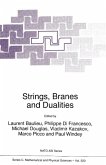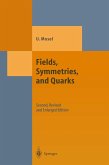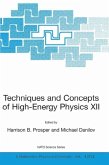Antonio Dobado, Angel Gomez-Nicola, Antonio L. Maroto, Jose R. Pelaez
Effective Lagrangians for the Standard Model (eBook, PDF)
56,95 €
56,95 €
inkl. MwSt.
Sofort per Download lieferbar

28 °P sammeln
56,95 €
Als Download kaufen

56,95 €
inkl. MwSt.
Sofort per Download lieferbar

28 °P sammeln
Jetzt verschenken
Alle Infos zum eBook verschenken
56,95 €
inkl. MwSt.
Sofort per Download lieferbar
Alle Infos zum eBook verschenken

28 °P sammeln
Antonio Dobado, Angel Gomez-Nicola, Antonio L. Maroto, Jose R. Pelaez
Effective Lagrangians for the Standard Model (eBook, PDF)
- Format: PDF
- Merkliste
- Auf die Merkliste
- Bewerten Bewerten
- Teilen
- Produkt teilen
- Produkterinnerung
- Produkterinnerung

Bitte loggen Sie sich zunächst in Ihr Kundenkonto ein oder registrieren Sie sich bei
bücher.de, um das eBook-Abo tolino select nutzen zu können.
Hier können Sie sich einloggen
Hier können Sie sich einloggen
Sie sind bereits eingeloggt. Klicken Sie auf 2. tolino select Abo, um fortzufahren.

Bitte loggen Sie sich zunächst in Ihr Kundenkonto ein oder registrieren Sie sich bei bücher.de, um das eBook-Abo tolino select nutzen zu können.
This book will be useful for graduate students as well as particle physicists, from those who are just willing to obtain an overview of these subjects, up to those who want to start doing research.
- Geräte: PC
- ohne Kopierschutz
- eBook Hilfe
- Größe: 40.68MB
Andere Kunden interessierten sich auch für
![Strings, Branes and Dualities (eBook, PDF) Strings, Branes and Dualities (eBook, PDF)]() Strings, Branes and Dualities (eBook, PDF)160,95 €
Strings, Branes and Dualities (eBook, PDF)160,95 €![Particle Physics (eBook, PDF) Particle Physics (eBook, PDF)]() Christoph BergerParticle Physics (eBook, PDF)60,95 €
Christoph BergerParticle Physics (eBook, PDF)60,95 €![QCD at 200 TeV (eBook, PDF) QCD at 200 TeV (eBook, PDF)]() QCD at 200 TeV (eBook, PDF)40,95 €
QCD at 200 TeV (eBook, PDF)40,95 €![CP Violation Without Strangeness (eBook, PDF) CP Violation Without Strangeness (eBook, PDF)]() Iosif B. KhriplovichCP Violation Without Strangeness (eBook, PDF)72,95 €
Iosif B. KhriplovichCP Violation Without Strangeness (eBook, PDF)72,95 €![Fields, Symmetries, and Quarks (eBook, PDF) Fields, Symmetries, and Quarks (eBook, PDF)]() Ulrich MoselFields, Symmetries, and Quarks (eBook, PDF)40,95 €
Ulrich MoselFields, Symmetries, and Quarks (eBook, PDF)40,95 €![Techniques and Concepts of High-Energy Physics XII (eBook, PDF) Techniques and Concepts of High-Energy Physics XII (eBook, PDF)]() Techniques and Concepts of High-Energy Physics XII (eBook, PDF)72,95 €
Techniques and Concepts of High-Energy Physics XII (eBook, PDF)72,95 €![Nuclear and Particle Physics (eBook, PDF) Nuclear and Particle Physics (eBook, PDF)]() Mira DeyNuclear and Particle Physics (eBook, PDF)40,95 €
Mira DeyNuclear and Particle Physics (eBook, PDF)40,95 €-
-
-
This book will be useful for graduate students as well as particle physicists, from those who are just willing to obtain an overview of these subjects, up to those who want to start doing research.
Dieser Download kann aus rechtlichen Gründen nur mit Rechnungsadresse in A, B, BG, CY, CZ, D, DK, EW, E, FIN, F, GR, HR, H, IRL, I, LT, L, LR, M, NL, PL, P, R, S, SLO, SK ausgeliefert werden.
Produktdetails
- Produktdetails
- Verlag: Springer Berlin Heidelberg
- Seitenzahl: 316
- Erscheinungstermin: 6. Dezember 2012
- Englisch
- ISBN-13: 9783642591914
- Artikelnr.: 53394231
- Verlag: Springer Berlin Heidelberg
- Seitenzahl: 316
- Erscheinungstermin: 6. Dezember 2012
- Englisch
- ISBN-13: 9783642591914
- Artikelnr.: 53394231
- Herstellerkennzeichnung Die Herstellerinformationen sind derzeit nicht verfügbar.
1. The Notion of Effective Lagrangian.- 1.1 Introduction.- 1.2 Integration of the Heavy Modes.- 1.3 The Decoupling Theorem.- 1.4 The Euler-Heisenberg Lagrangian.- 1.5 Theories with Spontaneous Symmetry Breaking.- 1.6 Decoupling of Chiral Fermions.- 1.7 References.- 2. Global Symmetries in Quantum Field Theory.- 2.1 Classical Symmetries.- 2.2 Green Functions and the Reduction Formula.- 2.3 Quantum Symmetries and Ward Identities.- 2.4 Spontaneous Symmetry Breaking and the Goldstone Theorem.- 2.5 Explicit Symmetry Breaking and the Dashen Conditions.- 2.6 References.- 3. The Non-linear ? Model.- 3.1 Introduction.- 3.2 The Geometry and the Dynamics of the Non-linear ? Model.- 3.3 The Quantum Non-linear ? Model.- 3.4 Reparametrization Invariance of the S-Matrix Elements.- 3.5 Local Symmetries and the Higgs Mechanism.- 3.6 Topologically Non-trivial Configurations.- 3.7 References.- 4. Anomalies.- 4.1 Introduction.- 4.2 The Axial Anomaly, Triangle Diagrams and the ?0 Decay.- 4.3 The Axial Anomaly and the Index Theorem.- 4.4 Gauge Anomalies.- 4.5 Regularization Methods.- 4.6 Ambiguities and Counterterms.- 4.7 Topological Interpretation of Non-Abelian Anomalies.- 4.8 Non-perturbative Anomalies.- 4.9 Non-linear ? Model Anomalies.- 4.10 The Wess-Zumino-Witten Term.- 4.11 The Trace Anomaly.- 4.12 References.- 5. The Symmetries of the Standard Model.- 5.1 The Elements of the Standard Model.- 5.2 The Cabibbo-Kobayashi-Maskawa Matrix and Weak CP Violation.- 5.3 The Cancellation of Gauge Anomalies in the Standard Model.- 5.4 Baryon and Lepton Number Anomalies in the Standard Model.- 5.5 The Evolution of the Coupling Constants.- 5.6 The Strong CP Problem.- 5.7 The Symmetries of the Standard Model.- 5.8 References.- 6. The Effective Lagrangian for QCD.- 6.1 The QCD Lagrangian.- 6.2QCD at Low Energies.- 6.3 The Chiral Lagrangian at Leading Order.- 6.4 The Chiral Lagrangian to Next to Leading Order.- 6.5 The Low-Energy Constants.- 6.6 The Problem of Unitarity in ChPT.- 6.7 References.- 7. The Standard Model Symmetry Breaking Sector.- 7.1 The Mass Problem.- 7.2 The Effective Lagrangian for the SM Symmetry Breaking Sector.- 7.3 The O(p4) Lagrangian and One-Loop Renormalization.- 7.4 The Heavy Higgs and QCD-Like Models.- 7.5 Phenomenological Determination of the Chiral Parameters.- 7.6 The Equivalence Theorem.- 7.7 The Applicability of the Equivalence Theorem.- 7.8 Gauge Boson Scattering at High Energies.- 7.9 References.- 8. Gravity and the Standard Model.- 8.1 Introduction.- 8.2 The Standard Model in Curved Space-Time.- 8.3 Anomalies in the Standard Model.- 8.4 The Effect of Matter Fields on Gravitation.- 8.5 The Effective Action for Gravity.- 8.6 References.- A. Useful Formulae and Notation.- B. Notes on Differential Geometry.- C. Aspects of Quantum Field Theory.- D. Unitarity and Partial Waves.
1. The Notion of Effective Lagrangian.- 1.1 Introduction.- 1.2 Integration of the Heavy Modes.- 1.3 The Decoupling Theorem.- 1.4 The Euler-Heisenberg Lagrangian.- 1.5 Theories with Spontaneous Symmetry Breaking.- 1.6 Decoupling of Chiral Fermions.- 1.7 References.- 2. Global Symmetries in Quantum Field Theory.- 2.1 Classical Symmetries.- 2.2 Green Functions and the Reduction Formula.- 2.3 Quantum Symmetries and Ward Identities.- 2.4 Spontaneous Symmetry Breaking and the Goldstone Theorem.- 2.5 Explicit Symmetry Breaking and the Dashen Conditions.- 2.6 References.- 3. The Non-linear ? Model.- 3.1 Introduction.- 3.2 The Geometry and the Dynamics of the Non-linear ? Model.- 3.3 The Quantum Non-linear ? Model.- 3.4 Reparametrization Invariance of the S-Matrix Elements.- 3.5 Local Symmetries and the Higgs Mechanism.- 3.6 Topologically Non-trivial Configurations.- 3.7 References.- 4. Anomalies.- 4.1 Introduction.- 4.2 The Axial Anomaly, Triangle Diagrams and the ?0 Decay.- 4.3 The Axial Anomaly and the Index Theorem.- 4.4 Gauge Anomalies.- 4.5 Regularization Methods.- 4.6 Ambiguities and Counterterms.- 4.7 Topological Interpretation of Non-Abelian Anomalies.- 4.8 Non-perturbative Anomalies.- 4.9 Non-linear ? Model Anomalies.- 4.10 The Wess-Zumino-Witten Term.- 4.11 The Trace Anomaly.- 4.12 References.- 5. The Symmetries of the Standard Model.- 5.1 The Elements of the Standard Model.- 5.2 The Cabibbo-Kobayashi-Maskawa Matrix and Weak CP Violation.- 5.3 The Cancellation of Gauge Anomalies in the Standard Model.- 5.4 Baryon and Lepton Number Anomalies in the Standard Model.- 5.5 The Evolution of the Coupling Constants.- 5.6 The Strong CP Problem.- 5.7 The Symmetries of the Standard Model.- 5.8 References.- 6. The Effective Lagrangian for QCD.- 6.1 The QCD Lagrangian.- 6.2QCD at Low Energies.- 6.3 The Chiral Lagrangian at Leading Order.- 6.4 The Chiral Lagrangian to Next to Leading Order.- 6.5 The Low-Energy Constants.- 6.6 The Problem of Unitarity in ChPT.- 6.7 References.- 7. The Standard Model Symmetry Breaking Sector.- 7.1 The Mass Problem.- 7.2 The Effective Lagrangian for the SM Symmetry Breaking Sector.- 7.3 The O(p4) Lagrangian and One-Loop Renormalization.- 7.4 The Heavy Higgs and QCD-Like Models.- 7.5 Phenomenological Determination of the Chiral Parameters.- 7.6 The Equivalence Theorem.- 7.7 The Applicability of the Equivalence Theorem.- 7.8 Gauge Boson Scattering at High Energies.- 7.9 References.- 8. Gravity and the Standard Model.- 8.1 Introduction.- 8.2 The Standard Model in Curved Space-Time.- 8.3 Anomalies in the Standard Model.- 8.4 The Effect of Matter Fields on Gravitation.- 8.5 The Effective Action for Gravity.- 8.6 References.- A. Useful Formulae and Notation.- B. Notes on Differential Geometry.- C. Aspects of Quantum Field Theory.- D. Unitarity and Partial Waves.







